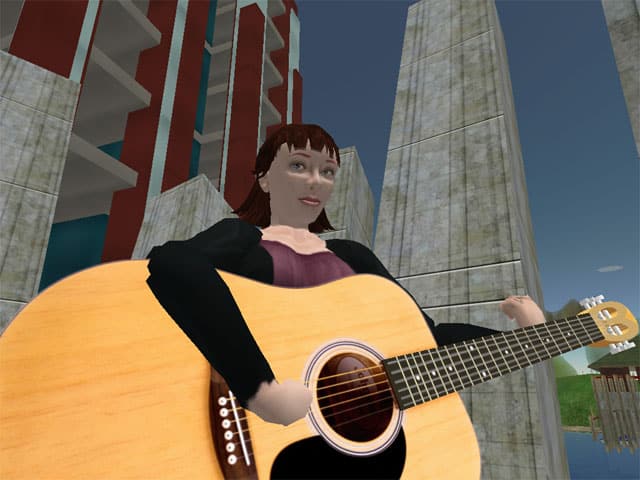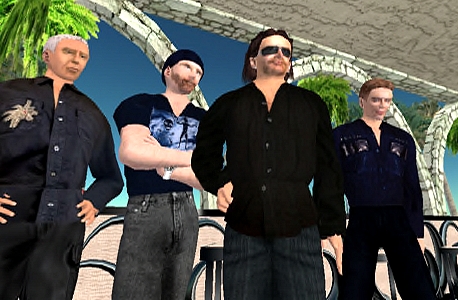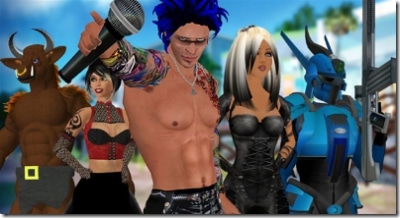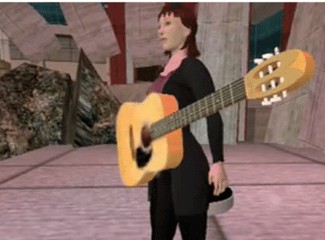
Move over, MySpace: Pop legends and aspiring rock stars are heading for an online outlet that’s more Sims than social networking.
With thousands of bands now crowding the pages of MySpace.com, acts like Duran Duran and Suzanne Vega are turning to the online virtual world of Second Life to make themselves heard.
Artists are creating avatars and using the game’s audio-streaming features to play ‘live’ concerts on stages made of polygons. With nearly 400,000 members, Second Life is considered by some record companies to be a good venue to reach fans.
‘Certainly it’s part novelty, but I also see it as endemic to music to push performance into different dimensions,’ said Ethan Kaplan, senior director of technology at Warner Bros. Records.
Later this month, the ’80s superband Duran Duran will perform on its very own 3-D luxury island. Rap star Talib Kweli is set to join in, according to Kaplan.
‘When the video revolution began we instantly saw the opportunity to experiment and explore a new form of expression to enhance the musical experience,’ said keyboard player Nick Rhodes in a statement. ‘ Second Life is the future right now, offering endless possibilities for artists.’
On Aug. 3, singer Suzanne Vega became the first major artist to play a live gig in Second Life. The performance was simultaneously broadcast on public radio, with someone controlling Vega’s online avatar as she sang.
Rapper Chamillionaire and grunge five-piece Hinder have conducted meet-and-greets with fans inside Second Life, while BBC Radio 1 also staged its Big Weekend festival in the space, as well as in Dundee, Scotland.
In April, U2 devotees created avatars of the Irish band to re-enact a show from the quartet’s Vertigo tour.

New York singer and pianist Regina Spektor held a listening party in a facsimile of a Manhattan loft.
The big names, however, are following in the footsteps of members of Second Life‘s growing unsigned music scene. To many amateur artists, the virtual world represents a good way to build a following.
‘There’s more and more live musicians playing on here every week,’ said Melanie Fudge, a Welsh acoustic songwriter who performs in-world from home most nights under the alias ‘Mel Cheeky.’ Fudge said there’s no equipment to lug around, she doesn’t have to drive and she can mind her son while performing.
‘There’s a crowd of 30 to 45 that show up to every online event (and) I have sold many more CDs through Second Life than I did previously,’ she said.
Artists like Fudge use a microphone to pipe real-world performances into the 3-D space after billing gigs on the community’s events calendar.
The roster of artists covers many genres, from jazz musician ‘ Astrin Few‘ and pianist Kevin Noble to indie songwriter ‘ Cylindrian Rutabaga.’
Some of the best talents will play in person at the Second Life Community Convention in San Francisco this weekend.

Online, there’s a growing number of virtual venues at which to sing, from Irish pubs to amphitheaters. ‘You’ll find venues in the strangest of places, from deep underground to high in the sky,’ said ‘ Martha Cookie,’ a music promoter who declined to give her real name but who commissioned the impressive Muse Arena, which claims to be Second Life‘s most popular gig spot.
‘I run anywhere between a half-dozen to a dozen gigs a week,’ she said. ‘There must be well over a hundred live performers now; we’re regularly seeing numbers of up to 90 and a growing trend of music lovers logging in specifically for the gigs.’
Followers of in-world artists are often sent an instant message, inviting them to ‘teleport’ to performances minutes before they start. They beam into the in-world venue where the concert is taking place.
Performers are rewarded with a growing fan base, spots on real-world podcasts and invitations to play online festivals like the City Stages concert in April.
‘The environment is vastly different from any social-networking site,’ Cookie said. ‘It allows unprecedented levels of interaction between performer and audience.’

